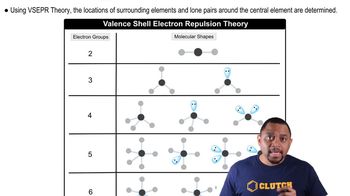Textbook Question
Determine the molecular geometry and sketch each molecule or ion, using the bond conventions shown in “Representing Molecular Geometries on Paper” in Section 11.4. b. SCl4
 Tro 6th Edition
Tro 6th Edition Ch.11 - Chemical Bonding II: Molecular Shapes, VSEPR & MO Theory
Ch.11 - Chemical Bonding II: Molecular Shapes, VSEPR & MO Theory Problem 41
Problem 41



Determine the molecular geometry and sketch each molecule or ion, using the bond conventions shown in “Representing Molecular Geometries on Paper” in Section 11.4. b. SCl4
Determine the molecular geometry and sketch each molecule or ion, using the bond conventions shown in “Representing Molecular Geometries on Paper” in Section 11.4. c. ClF3
Determine the molecular geometry and sketch each molecule or ion, using the bond conventions shown in “Representing Molecular Geometries on Paper” in Section 11.4. d. IF2–
Determine the molecular geometry about each interior atom and sketch each molecule. a. N2
Determine the molecular geometry about each interior atom and sketch each molecule. b. N2H2 (skeletal structure HNNH)
Determine the molecular geometry about each interior atom and sketch each molecule. c. N2H4 (skeletal structure H2NNH2)